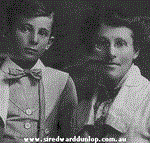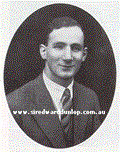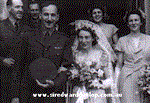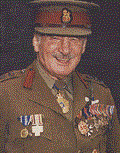 |
| Edward during his apprenticeship |
Biography:
Ernest Edward Dunlop was born on 12 July, 1907 at Wangaratta, Victoria. Edward (or Ernie or Ern as he was called), lived on his father's farm at Sheepwash Creek and was exposed to a culture of hardship and extremes from an early age. He loved listening to tales about members of his family that had gone to the First World War. As a boy he was excited about the adventure and challenges of his era; he longed for the bugles of the distant battle that was then raging.
 |
| Edward during his apprenticeship |
Edward was a child of high intellect, and he claimed that he was only doing as much as necessary on his schoolwork, even when he received excellent grades. At 16 years of age, he left Benalla High School and accepted an apprenticeship with the local chemist; Mr. W. M. McCall Say. Edward also entered a correspondence course with the “College of Pharmacy” in Melbourne at the same age. In 1927, he became restless and left the small town for Melbourne and completed his finished his course in medicine. He finished first in his class and received the first H.T. Tompsitt Scholarship. Later he was informed that he had of several other awards of his including: The Gold Medal of the Pharmaceutical Society, the Silver Medal for Botany and certificates of Honour in Chemistry and Materia Medica. This not only gave Edward Dunlop a great sense of accomplishment, but the opportunity to become one of Australia's best known surgeons. As well as having great academic results, he played rugby with the Wallabies and was the college’s champion boxer.
 |
| Edward being married |
Soon after graduating Weary took a job as a ship's surgeon and sailed to London. The next year World War Two broke out. Edward knew his skills were needed closer to the action, so Edward joined the Coburg/Brunswick Battalion of the Citizen Military Forces and from there he enrolled in the Royal Australian Army Medical Corps (R.A.A.M.C.) where he was commissioned as a Captain as well as being given the nickname 'Weary'. A year after enlisting, Edward was sent to Java, Indonesia. In 1946, Edward returned to Melbourne from his biggest adventure and married Helen Ferguson, his sweetheart: they had engaged for six years. They had two children and in 1969 he was knighted for his contribution to medicine and became Australian of The year in 1976. On the 2nd of July 1993, Sir Edward Dunlop passed away. A state funeral was held at St. Patrick's Cathedral. Around ten thousand people lined the streets of Melbourne for his funeral and a wonderful tribute was delivered by former High Court Justice and Governor General Sir Ninian Stephen.
 |
| Sir Edward Dunlop at his last Anzac day |
Feature Article:
Sir Edward Weary Dunlop was a surgeon in the Australian Army during World War Two. He is legendary for his care of soldiers taken prisoner by the Japanese. At the beginning of the Second World War, Edward was eager to join the army and immediately enlisted quoting, “I couldn’t get into the army quick enough.” He contrived to find a way around the standard process, which required him to return to Australia first, and was posted to an Australian Unit in Jerusalem, Palestine. Edward continued to serve in the Royal Australian Medical Corps and went to Crete, Greece and the Middle East.
 |
| Edward being knighted |
A year after his initial enlisting, he travelled to Java, Indonesia. The Japanese had attacked the island and Edward had been called in to help treat the injured. After only two weeks in Java, the hospital in which Edward Dunlop worked was taken over by the Japanese. Edward had the chance to escape, but could not leave his patients behind. All the prisoners were shipped to Singapore and then to Burma, where they were crammed into rice trucks and taken to Thailand. The Japanese forced them to build a 421km long railway from western Thailand to Burma. This railway became known as the “Railway of Death” because it took roughly one hundred thousand lives overall. To build a railway, you need strength, good health and good tools. The prisoners had none of these things. After many days of hard labour, Edward quoted, “I’d see these fellas at the crack of dawn, just carrying their rice for the day, and then they would drag in any time up until midnight, some of them on their hands and knees.” Edward had to decide who was in the right state to work and who wasn’t and he also had to tend to the prisoners wounds as well. Edward “Weary” Dunlop didn’t have much time to relax and was always on his feet. Someone that worked with him quoted, “Weary was never sitting down. He was always on his feet, and his feet were terrible with ulcers. He had all these complaints too, you know. The germs didn't leave him alone.”
Many men owed their lives to Edward including Bill Griffiths a disabled prisoner. The Japanese planned to kill him because they could not find a use for a disabled man. Bill was about to get shot when Edward came along and stood inbetween Bill and the bayonets and eventually Bill’s life was spared. Edward nearly got executed one day but the Japanese changed their mind and tortured him instead. He later quoted, “I got handcuffed around a tree, my tummy exposed to four bayonets and a countdown. Things were pretty grim." When the war finally ended, Edward continued to be a Surgeon in Australia and some of Asia. He met some of his former enemies and forgave them. He was later knighted and eventually died in 1993.
Page created on 10/31/2007 12:00:00 AM
Last edited 10/31/2007 12:00:00 AM
